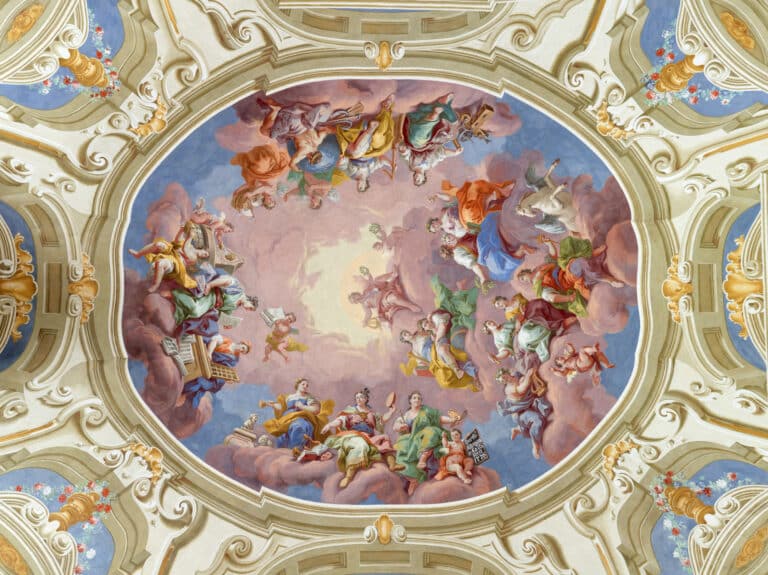The frescoes in the Admont monastery library
A masterpiece by Bartolomeo Altomonte
Frescoes
The fresco cycle in the seven vaulted domes was created by Bartolomeo Altomonte (1694-1783).
The painter undertook this work at the age of 80 and completed it during the summer months of 1775 and 1776. The fundamental theme of this seven-part cycle of paintings is the intimate connection between religion and the arts and sciences.
THE REVELATION
The theme of Revelation as the foundation of the Christian religion is located in the large central dome. At the center of this painting, the personified divine wisdom is enthroned. To her left is Moses, representing the Old Testament, and to her right is a female figure with a tiara, personifying the Church as a representative of the New Covenant. Below them – akin to the foundation of Christian doctrine – are depicted the four Latin Church Fathers.

SCIENCES AND ARTS
The six adjacent domes on the north and south sides depict the various sciences and arts, which are briefly described here with their respective central theme: The first picture at the south-facing library entrance is dedicated to the theme of arts and techniques. Apollo is depicted in the centre as the god of poetry and light and is enthroned above the nine muses. Sculpture, music and painting are depicted allegorically as female figures. The second vault is dedicated to medicine and science. The main figure is a man dressed in a doctor's robe with a staff of Asclepius, who hands a prescription to a female figure personifying pharmacy. This main group is surrounded by personifications of other natural sciences, such as physics, mineralogy, astronomy, geography and arithmetic.
The third fresco depicts theology and religion. In the centre is the personification of theology as a female figure with the sun on her chest. Next to her are the dove of the Holy Spirit and a woman symbolising "Truth". Below her - again depicted as women - are the three divine virtues of faith, hope and love. Revelation as the centre and climax can be seen in the central dome.
JURISPRUDENCE
The fifth fresco, with its two allegories of spiritual and secular law, represents jurisprudence. Floating above them is a genius holding the scales, the well-known symbol of justice. In the center of the sixth dome fresco, allegorically expressing historical research, there is a winged genius and a female figure pointing to a basket carried by putti, containing a multitude of disordered books, likely symbolizing diverse historical sources. Below, Chronos is depicted as the god of time.
AWAKENING OF THE SPIRIT
The seventh dome concludes this cycle of paintings, honoring the awakening of the mind in thought and speech. At the center of the painting is Aurora, the goddess of dawn. Leading the way is an enlightened torch, meant to dispel darkness and, metaphorically, ignorance. To her left and right stand the personifications of 'Grammar and Dialectic' as fundamental disciplines of language mastery and intellectual activity.
















